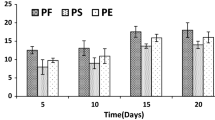Abstract
Twelve white-rot fungal strains belonging to seven different species were screened on plates under alkaline condition to study the decolourisation of the textile dyes Reactive Black 5 and Poly R-478. Three strains of Trametes versicolor (Micoteca da Universidade do Minho (MUM) 94.04, 04.100 and 04.101) and one strain of Phanerochaete chrysosporium (MUM 94.15) showed better decolourisation results. These four strains were used for decolourisation studies in liquid culture medium. All four selected strains presented more efficient decolourisation rates on Reactive Black 5 than on Poly R-478. For both dyes on solid and liquid culture media, the decolourisation capability exhibited by these strains depended on dye concentration and pH values of the media. Finally, the decolourisation of Reactive Black 5 by T. versicolor strains MUM 94.04 and 04.100 reached 100 %. In addition, the highest white-rot fungi ligninolytic enzyme activities were found for these two strains.

Similar content being viewed by others
References
Anastasi A, Spina F, Prigione V, Tigini V, Giansanti P, Varese GC (2010) Scale-up of a bioprocess for textile wastewater treatment using Bjerkandera adusta. Bioresource Technol 101:3067–3075
Anastasi A, Parato B, Spina F, Tigini V, Prigione V, Varese GC (2011) Decolourisation and detoxification in the fungal treatment of textile wastewaters from dyeing processes. New Biotechnol 29:38–45
Aravind UK, George B, Baburaj MS, Thomas S, Thomas AP, Aravindakumar CT (2010) Treatment of industrial effluents using polyelectrolyte membranes. Desalination 252:27–32
Asgher M, Azim N, Bhatti HN (2009) Decolorization of practical textile industry effluents by white rot fungus Coriolus versicolor IBL-04. Biochem Eng J 47:61–65
Barrasa JM, Martínez AT, Martínez MJ (2009) Isolation and selection of novel basidiomycetes for decolorization of recalcitrant dyes. Folia Microbiol 54:59–66
Enayatzamir K, Tabandeh F, Yakhchali B, Alikhani HA, Couto SR (2009) Assessment of the joint effect of laccase and cellobiose dehydrogenase on the decolouration of different synthetic dyes. J Hazard Mater 169:176–181
Faraco V, Pezzella C, Miele A, Giardina P, Sannia G (2009) Bio-remediation of colored industrial wastewaters by the white-rot fungi Phanerochaete chrysosporium and Pleurotus ostreatus and their enzymes. Biodegradation 20:209–220
Kalpana D, Shim JH, Oh B-T, Senthil K, Lee YS (2011) Bioremediation of the heavy metal complex dye Isolan Dark Blue 2SGL-01 by white rot fungus Irpex lacteus. J Hazard Mater 98:198–205
Kaushik P, Malik A (2009) Fungal dye decolorization: recent advances and future potential. Environ Int 35:127–141
Lucas M, Mertens V, Corbisier A-M, Vanhulle S (2008) Synthetic dyes decolourisation by white-rot fungi: development of original microtitre plate method and screening. Enzym Microb Tech 42:97–106
Maalej-Kammoun M, Zouari-Mechichi H, Belbahri L, Woodward S, Mechichi T (2009) Malachite green decolourization and detoxification by the laccase from a newly isolated strain of Trametes sp. Int Biodeter Biodegr 63:600–606
Martins MAM, Lima N, Silvestre AJD, Queiroz MJ (2003) Comparative studies of fungal degradation of single or mixed bioaccessible reactive azo dyes. Chemosphere 52:967–973
Mechichi T, Mhiri N, Sayadi S (2006) Remazol Brilliant Blue R decolourization by the laccase from Trametes trogii. Chemosphere 64:998–1005
Moya R, Hernández M, García-Martín AB, Ball AS, Arias ME (2010) Contributions to a better comprehension of redox-mediated decolouration and detoxification of azo dyes by a laccase produced by Streptomyces cyaneus CECT 3335. Bioresour Technol 101:2224–2229
Mohammadi A, Nasernejad B (2009) Enzymatic degradation of anthracene by the white rot fungus Phanerochaete chrysosporium immobilized on sugarcane bagasse. J Hazard Mater 161:534–537
Neto SLM, Esteves PJ, Santos VTO, Paranhos AP, Cescato F, Vitali VM, Machado KMG (2011) Novel salt and alkali tolerant neotropical basidiomycetes for dye decolorisation in simulated textile effluent. World J Microbiol Biotechnol 27:2665–2673
Noreen R, Asgher M, Bhatti HN, Batool S, Asad MJ (2011) Phanerochaete chrysosporium IBL-03 secretes high titers of manganese peroxidase during decolorization of Drimarine Blue K2RL textile dye. Environ Technol 32:1239–1246
Novotný C, Dias N, Kapanen A, Malachová K, Vándrovcová M, Itävaara M, Lima N (2006) Comparative use of bacterial, algal and protozoan tests to study toxicity of azo- and anthraquinone dyes. Chemosphere 63:1436–1442
Prigione V, Tigini V, Pezzella C, Anastasi A, Sannia G, Varese GC (2008) Decolourisation and detoxification of textile effluents by fungal biosorption. Water Res 42:2911–2920
Ramya M, Anusha B, Kalavathy S, Devilaksmi S (2007) Biodecolorization and biodegradation of reactive blue by Aspergillus sp. Afr J Biotechnol 6:1441–1445
Reid R (1996) Go green - a sound business decision. J Soc Dyers Color 112:103–105
Revankar MS, Lele SS (2007) Synthetic dye decolorization by white rot fungus, Ganoderma sp. WR-1. Bioresource Technol 98:775–780
Rigas F, Dritsa V (2006) Decolourisation of a polymeric dye by selected fungal strains in liquid cultures. Enzym Microb Tech 39:120–124
Sukumar M, Sivasamy A, Swaminathan G (2009) In situ biodecolorization kinetics of Acid Red 66 in aqueous solutions by Trametes versicolor. J Hazard Mater 167:660–663
Toh Y-C, Jia J, Yen L, Obbard JP, Ting Y-P (2003) Decolourisation of azo dyes by white-rot fungi (WRF) isolated in Singapore. Enzym Microb Tech 33:569–575
Yesilada O, Yildirim SC, Birhanli E, Apohan E, Asma D, Kuru F (2010) The evaluation of pre-grown mycelial pellets in decolorization of textile dyes during repeated batch process. World J Microb Biot 26:33–39
Author information
Authors and Affiliations
Corresponding author
Rights and permissions
About this article
Cite this article
Ottoni, C.A., Santos, C., Kozakiewicz, Z. et al. White-rot fungi capable of decolourising textile dyes under alkaline conditions. Folia Microbiol 58, 187–193 (2013). https://doi.org/10.1007/s12223-012-0196-4
Received:
Accepted:
Published:
Issue Date:
DOI: https://doi.org/10.1007/s12223-012-0196-4




